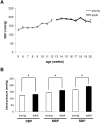Hemodynamic, morphometric and autonomic patterns in hypertensive rats - Renin-Angiotensin system modulation
- PMID: 20126350
- PMCID: PMC2815287
- DOI: 10.1590/S1807-59322010000100013
Hemodynamic, morphometric and autonomic patterns in hypertensive rats - Renin-Angiotensin system modulation
Abstract
Background: Spontaneously hypertensive rats develop left ventricular hypertrophy, increased blood pressure and blood pressure variability, which are important determinants of heart damage, like the activation of renin-angiotensin system.
Aims: To investigate the effects of the time-course of hypertension over 1) hemodynamic and autonomic patterns (blood pressure; blood pressure variability; heart rate); 2) left ventricular hypertrophy; and 3) local and systemic Renin-angiotensin system of the spontaneously hypertensive rats.
Methods: MALE SPONTANEOUSLY HYPERTENSIVE RATS WERE RANDOMIZED INTO TWO GROUPS: young (n=13) and adult (n=12). Hemodynamic signals (blood pressure, heart rate), blood pressure variability (BPV) and spectral analysis of the autonomic components of blood pressure were analyzed. LEFT ventricular hypertrophy was measured by the ratio of LV mass to body weight (mg/g), by myocyte diameter (mum) and by relative fibrosis area (RFA, %). ACE and ACE2 activities were measured by fluorometry (UF/min), and plasma renin activity (PRA) was assessed by a radioimmunoassay (ng/mL/h). Cardiac gene expressions of Agt, Ace and Ace2 were quantified by RT-PCR (AU).
Results: The time-course of hypertension in spontaneously hypertensive rats increased BPV and reduced the alpha index in adult spontaneously hypertensive rats. Adult rats showed increases in left ventricular hypertrophy and in RFA. Compared to young spontaneously hypertensive rats, adult spontaneously hypertensive rats had lower cardiac ACE and ACE2 activities, and high levels of PRA. No change was observed in gene expression of Renin-angiotensin system components.
Conclusions: The observed autonomic dysfunction and modulation of Renin-angiotensin system activity are contributing factors to end-organ damage in hypertension and could be interacting. Our findings suggest that the management of hypertensive disease must start before blood pressure reaches the highest stable levels and the consequent established end-organ damage is reached.
Keywords: Blood pressure variability; Hypertension; LVH; RAS; SHR.
Figures

References
-
- Diamond JA, Phillips RA. Hypertensive heart disease. Hypertens Res. 2005;28:191–202. - PubMed
-
- Agabiti-Rosei E, Muiesan ML. Left ventricular hypertrophy and heart failure in women. J Hypertens Suppl. 2002;20:S34–8. - PubMed
-
- Ruilope LM, Schmieder RE. Left ventricular hypertrophy and clinical outcomes in hypertensive patients. Am J Hypertens. 2008;21:500–8. - PubMed
-
- Parati G, Ravogli A, Frattola A, Groppelli A, Ulian L, Santucciu C, et al. Blood pressure variability: clinical implications and effects of antihypertensive treatment. J Hypertens Suppl. 1994;12:S35–40. - PubMed
-
- Su DF, Miao CY. Reduction of blood pressure variability: a new strategy for the treatment of hypertension. Trends Pharmacol Sci. 2005;26:388–90. - PubMed
Publication types
MeSH terms
Substances
LinkOut - more resources
Full Text Sources
Medical
Research Materials
Miscellaneous

